|
CLICK BUTTON TO GO |
|
|
|
|
|
|
|
|
|
|
|
|
|
Videos |
|
|
|
|
|
|
|
|
|
|
|
|
|
PART 1 T O P I C |
|
|
|
|
|
|
|
|
|
|
|
|
|
|
|
|
|
|
JewishWikipedia.info
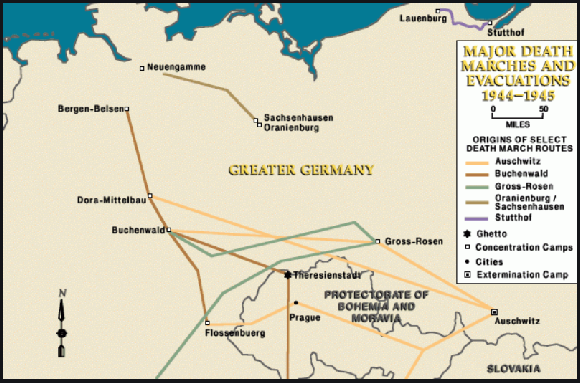
Holocaust Encyclopedia
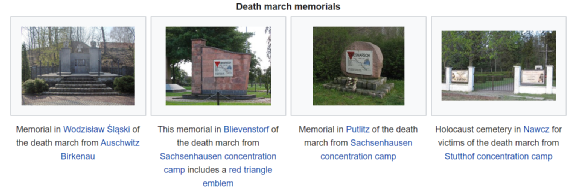
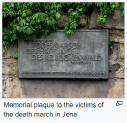
DEATH MARCHES
Holocaust Encyclopedia
A massive Soviet 1944 summer offensive in eastern Belarus annihilated German Army Group Center and permitted Soviet forces to overrun the first of the major Nazi concentration camps, Lublin/Majdanek. Shortly after that offensive, SS chief (Reichsfuehrer SS) Heinrich Himmler ordered that prisoners in all concentration camps and subcamps be evacuated toward the interior of the Reich. Due to the rapid Soviet advance, the SS had not had time to complete the evacuation of Majdanek. Soviet and western media widely publicized SS atrocities at the camp, using both footage of the camp at liberation and interviews with some of the surviving prisoners. The evacuations of the concentration camps had three purposes:
(1) SS authorities did not want prisoners to fall into enemy hands alive to tell their stories to Allied and Soviet liberators
(2) the SS thought they needed prisoners to maintain production of armaments wherever possible
(3) some SS leaders, including Himmler, believed irrationally that they could use Jewish concentration camp prisoners as hostages to bargain for a separate peace in the west that would guarantee the survival of the Nazi regime.
In the summer and early autumn months of 1944, most of the evacuations were carried out by train or, in the case of German positions cut off in the Baltic States, by ship. As winter approached, however, and the Allies reached the German borders and assumed full control of German skies, SS authorities increasingly evacuated concentration camp prisoners from both east and west on foot.
By January 1945, the Third Reich stood on the verge of military defeat. Most of German East Prussia was already under Soviet occupation. Soviet forces besieged Warsaw, Poland, and Budapest, Hungary, as they prepared to push German forces back toward the interior of the Reich. After the failure of the surprise German Ardennes offensive in December 1944, Anglo-American forces in the west were ready to invade Germany.
The SS guards had strict orders to kill prisoners who could no longer walk or travel. As evacuations depended increasingly on forced marches and travel by open rail car or small craft in the Baltic Sea in the brutal winter of 1944-1945, the number who died of exhaustion and exposure along the routes increased dramatically. This encouraged an understandable perception among the prisoners that the Germans intended them all to die on the march. The term death march was probably coined by concentration camp prisoners.
During these death marches, the SS guards brutally mistreated the prisoners. Following their explicit orders, they shot hundreds of prisoners who collapsed or could not keep pace on the march, or who could no longer disembark from the trains or ships. Thousands of prisoners died of exposure, starvation, and exhaustion. Forced marches were especially common in late 1944 and 1945, as the SS evacuated prisoners to camps deeper within Germany. Major evacuation operations moved prisoners out of Auschwitz, Stutthof, and Gross-Rosen westward to Buchenwald, Flossenbürg, Dachau, and Sachsenhausen in winter 1944-1945; from Buchenwald and Flossenbürg to Dachau and Mauthausen in spring 1945; and from Sachsenhausen and Neuengamme northwards to the Baltic Sea in the last weeks of the war.
As Allied forces advanced into the heart of Germany they liberated hundreds of thousands of concentration camp prisoners. This included thousands of prisoners whom Allied and Soviet troops liberated while they marched on the forced evacuations. On April 25, 1945, Soviet forces met US forces at Torgau, on the Elbe River in central Germany. The German armed forces surrendered unconditionally in the west on May 7 and in the east on May 9, 1945. May 8, 1945, was proclaimed Victory in Europe Day (V-E Day).
To almost the last day of the war, German authorities marched prisoners to various locations in the Reich. As late as May 1, 1945, prisoners who had been evacuated from Neuengamme to the North Sea coastline were loaded onto ships; hundreds of them died when the British bombed the ships a few days later, thinking that they carried German military personnel.
DEATH MARCHES (HOLOCAUST)
Wikipedia
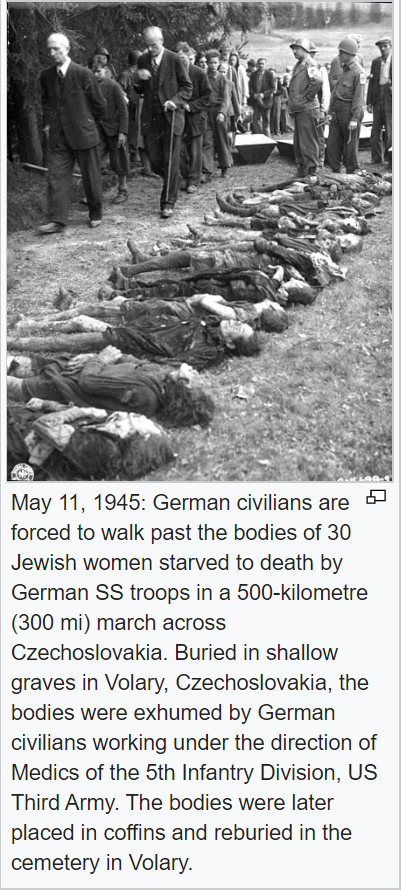 Death marches (Todesmärsche in German) refers to the forcible movements of prisoners of Nazi Germany between Nazi camps during World War II. They occurred at various points during the Holocaust, including 1939 in the Lublin province of Poland, in 1942 in Reichskommissariat Ukraine and across the General Government, and between Autumn 1944 and late April 1945 near the Soviet front, from the Nazi concentration camps and prisoner of war camps situated in the new Reichsgaue, to camps inside Germany proper, away from reach of the Allied forces. The purpose was to remove evidence of crimes against humanity committed inside the camps and to prevent the liberation of German-held prisoners of war
Death marches (Todesmärsche in German) refers to the forcible movements of prisoners of Nazi Germany between Nazi camps during World War II. They occurred at various points during the Holocaust, including 1939 in the Lublin province of Poland, in 1942 in Reichskommissariat Ukraine and across the General Government, and between Autumn 1944 and late April 1945 near the Soviet front, from the Nazi concentration camps and prisoner of war camps situated in the new Reichsgaue, to camps inside Germany proper, away from reach of the Allied forces. The purpose was to remove evidence of crimes against humanity committed inside the camps and to prevent the liberation of German-held prisoners of war
Towards the end of World War II in 1945, Nazi Germany had evacuated an estimated 10 to 15 million people, mostly from East Prussia and occupied Eastern and Central Europe. While the Allied forces advanced from the West, and the Red Army advanced from the East, trapped in the middle, the German SS divisions abandoned all Nazi concentration camps, moving or destroying evidence of the atrocities they had committed. Thousands of prisoners were killed in the camps before the marches commenced. These executions were deemed crimes against humanity during the Nuremberg trials.
Although most of the prisoners were already very weak or ill after enduring the routine violence, overwork, and starvation of concentration camp or prison camp life, they were marched for kilometres in the snow to railway stations, then transported for days at a time without food, water, or shelter in freight carriages originally designed for cattle. On arrival at their destination, they were then forced to march again to new camps. Prisoners who were unable to keep up due to fatigue or illness were usually executed by gunshot.
- The first evacuation of Majdanek inmates started in April 1944. The prisoners of Kaiserwald were transported to Stutthof or killed in August. Mittelbau-Dora was evacuated in April 1945.
- The largest death march in World War II was from Auschwitz-Birkenau to Loslau in January 1945.
- The SS killed large numbers of prisoners by starvation before the marches, and shot many more dead both during and after for not being able to keep pace. Seven hundred prisoners were killed during one ten-day march of 7,000 Jews, including 6,000 women, who were being moved from camps in the Danzig region. Those still alive when the marchers reached the coast were forced into the Baltic Sea and shot.
Elie Wiesel, Holocaust survivor and winner of the 1986 Nobel Peace Prize, describes in his 1958 book Night how he and his father, Shlomo, were forced on a death march from Buna to Gleiwitz.
CHEŁM TO HRUBIESZÓW, SOKAL AND BELZ
In December 1939, male Jews from Chełm, Poland aged between 16 and 60, were forced on a death march to the nearby town of Hrubieszów. There, Jews were rounded up and forced to join the Chełm Jews. They were split into two groups on separate marches to Sokal and Belz, both across the modern border between Poland and Ukraine. In all, an estimated 2,000 Jews were murdered on this death march. There were only a handful of survivors.
LUBLIN TO BIAŁA PODLASKA AND PARCZEW
In January 1940, the Germans deported a group of prisoners from the Lipowa 7 prisoner of war camp to Biała Podlaska and then to Parczew. They rushed them on foot among snowstorms and temperatures below −20 °C (−4 °F). Those POWs who did not follow orders were killed by the German guards. The inhabitants of the nearby villages were forced to collect and bury the bodies in mass graves. Only a small group of prisoners survived this march of death. A few were able to escape into the woods and join the partisans.
BELZ TO HRUBIESZOW
In early June 1942, Jews concentrated in Belz were driven in a 60-kilometre (37 mi) death march to Hrubieszow. Those who could not continue on the way were shot by the SS guards. All death march survivors were deported along with about 3,000 Jews from Hrubieszow to Sobibor.
AUSCHWITZ TO LOSLAU
The largest and the most notorious of the death marches took place in mid-January 1945. On January 12, the Soviet army began its Vistula-Oder Offensive, advancing on occupied Poland. By January 17, orders were given to vacate the Auschwitz concentration camp and its subcamps. Between the 17th and 21st, the SS began marching approximately 56,000 prisoners out of the Auschwitz camps mostly to west to Loslau (Polish: Wodzisław Śląski)63 km (39 mi) away, but also some to northwest to Gleiwitz (Polish: Gliwice) 55 km (34 mi) away and others. Temperatures of −20 °C (−4 °F) and lower were recorded at the time of these marches. Some residents of Upper Silesia tried to help the marching prisoners. Some of the prisoners themselves managed to escape the death marches to freedom. At least 3,000 prisoners died on the Gleiwitz route alone. Approximately 9,000-15,000 prisoners in total died on death marches out of Auschwitz's camps, and those who did survive were then put on freight trains and shipped to other camps deeper in German held territory.
STUTTHOF TO LAUENBURG
The evacuation of the about 50,000 prisoners from the Stutthof camp system in northern Poland began in January 1945. About 5,000 prisoners from Stutthof subcamps were marched to the Baltic Sea coast, forced into the water, and machine gunned. The rest of the prisoners were marched in the direction of Lauenburg in eastern Germany. They were cut off by the advancing Soviet forces. The Germans forced the surviving prisoners back to Stutthof. Marching in severe winter conditions and treated brutally by SS guards, thousands died during the march.
In late April 1945, the remaining prisoners were removed from Stutthof by sea, since it was completely encircled by Soviet forces. Again, hundreds of prisoners were forced into the sea and shot. Over 4,000 were sent by small boat to Germany, some to the Neuengamme concentration camp near Hamburg, and some to camps along the Baltic coast. Many drowned along the way. Shortly before the German surrender, some prisoners were transferred to Malmö, Sweden, and released to the care of that neutral country. It has been estimated that over 25,000 prisoners, around half, died during the evacuation from Stutthof and its subcamps. One hundred prisoners were liberated from Stutthof on May 9, 1945.
BUCHENWALD TO DACHAU, FLOSSENBÜRG AND THERESIENSTADT
In early 1945, Buchenwald had received numerous prisoners moved from camps further east in territory lost to the Soviets, and camp authorities began to close the outlying camps of Buchenwald (such as those in Apolda and Altenburg) to concentrate prisoners in the main camp. In April 1945, about 28,000 prisoners were marched from Buchenwald on a journey of over 300 kilometers through Jena, Eisenberg, Bad Köstritz, and Gera with the intended destination of Dachau, Flossenbürg, and Theresienstadt. The remaining 21,000 prisoners in Buchenwald were liberated by the U.S. Third Army on April 11, 1945.
DACHAU TO THE AUSTRIAN BORDER
On April 24, 1945, the satellite labor camps around Dachau were being cleared out by the Nazis ahead of the advancing Allied troops, and some 15,000 prisoners were first marched to the Dachau camp, only to be sent southwards on a death march towards the Austrian border, the path for which generally headed southwards, partly along the eastern shore of the Starnberger See, taking a left turn to the east in the town of Eurasburg and heading towards the Tegernsee. By the timeframe of the second of May 1945, only some of the 6,000 prisoners sent on the death march were still alive, as those in failing health were being shot dead as they fell along the route. On that day, as the eastwards-marching prisoners had passed through Bad Tölz and were nearing Waakirchen, nearly sixty kilometers (37 miles) south of Dachau, several hundred of them were lying on the open ground in ill health, and among them were some who had already died from ill health and exposure to the elements, nearly all covered in freshly-fallen snow. These prisoners were spotted by advance scouts of the U.S. Army's 522nd Field Artillery Battalion, the only segregated Japanese American-manned military unit in Germany at the time — who had, only days before, liberated the Kaufering IV Hurlach satellite slave labor camp of the Dachau main camp's "system", and many of whose own relatives were themselves interned during the war on American soil — with the American troops doing what they could in attempts to save those left alive, for at least two days before dedicated medical personnel could take over. A memorial to the rescue by the 522nd exists at 47°46′6.15″N 11°38′55.30″E, just under two kilometers west of the Waakirchen town centre.
WHAT HAPPENED TO THE SURVIVORS
The Weiner Holocaust Library
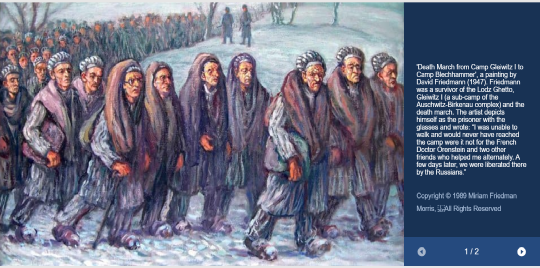
WHAT WERE THE DEATH MARCHES?
As the German army began to retreat westwards during the last months of the war, prisoners were marched and transported to camps in Germany and Austria.
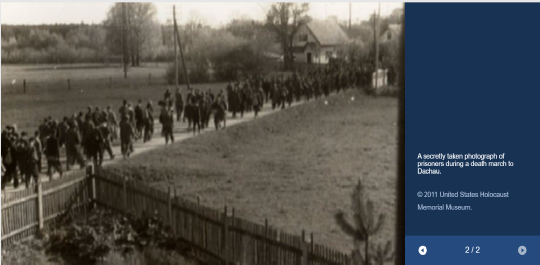 The Germans still wanted to exploit Jewish slave labour from the concentration camps and wanted to make sure that there were no witnesses to their crimes.
The Germans still wanted to exploit Jewish slave labour from the concentration camps and wanted to make sure that there were no witnesses to their crimes.
The death marches often lasted for weeks at a time. Up to 250,000 people died due to the appalling conditions they faced either through marching on foot or being herded into freight cars.
After the war many hundreds of mass graves containing the victims were found along the routes of the marches.
In November 1944 some 70,000 Jews from Budapest were marched to Dachau (in Germany) and Mauthausen (in Austria). Many thousands were murdered on the way.
Likewise, on 18 January 1945, 66,000 prisoners of Auschwitz-Birkenau and its sub-camps were evacuated, first on foot and then by open-top railway wagons. By the time the prisoners reached their destinations such as Gross-Rosen, Buchenwald, Dachau and Mauthausen in excess of 15,000 had died or were murdered by the guards. The SS also evacuated camps other camps in much the same manner.
FREDDIE REMEMBERS THE DEATH MARCH
As the German army began to retreat westwards during the last months of the war, prisoners were marched and transported to camps in Germany and Austria.
On 18 January 1945, 66,000 prisoners of Auschwitz-Birkenau and its sub-camps were evacuated, first on foot and then by open top railway wagons. Freddie was one of those prisoners. In this video Freddie talks about his experiences on the death march.
Listen to Freddie’s testimony and reflect on his experiences during the freezing cold weather of January 1945.
Please note that the lead in may take a few moments to allow the video to begin.
WHAT PROBLEMS DID SURVIVORS FACE?
By the end of the war, around two million Jews had survived in the Soviet Union. Hundreds of thousands survived the camps. Rescuers had hidden some; whilst others had survived on false papers. In Eastern Europe in particular some had survived in the forests.
As survivors began to return home to search for relatives they were often treated with hostility from the non-Jewish population. A lot of Jewish property had been taken, not by the Nazis, but by the local people. Many of the locals feared that the Jews would demand that their property and belongings be returned.
In Poland from the end of the war to the summer of 1946, Poles murdered approximately 1,500 Jewish survivors. Included in this number was the man who had led the Sobibor uprising.
On 4 July 1946 the Blood Libel was revived in Kielce, a town in southern Poland; 42 Jews were murdered and as many as 80 others were wounded during the pogrom which followed. This led to over 100,000 Jews fleeing Poland, many to displaced persons camps (DP) camps.
WHAT DID THE ALLIES FIND?
As the Allies fought their way across Europe, they discovered the concentration and death camps.
The conditions in the camps had always been terrible. However, by late 1944 and early 1945 the whole camp system was collapsing. The prisoners in the East were subjected to the death marches at the height of winter. The transportation to camps in Germany and Austria led to terrible overcrowding, resulting in many thousands of deaths. The Germans were unable to cope with the numbers within the camps. They could not house or feed the prisoners. This led to widespread starvation and disease.
As they liberated the camps the Allies discovered thousands of victims on the verge of death. In many camps they discovered piles of corpses.
In Bergen-Belsen during March 1945 around 18,000 prisoners of the camp died of disease or starvation. On 15 April 1945 the British army liberated the camp.
They found 60,000 prisoners. Many were dying and thousands of bodies lay unburied. The liberators were unprepared for the situation, but tried to help the survivors. Despite this 14,000 people died in the first weeks of liberation. Many died from disease. Some died because after prolonged starvation their stomachs and bodies just could not take normal food.
When Dachau was liberated on 29 April 1945, it held approximately 67,000 prisoners. Around one third of them were Jews. After liberation, around 250 survivors a day died in Dachau. Survivors of the camp had no possessions. In the beginning they still had to wear their prison uniforms as they had no clothes to wear.
In February 1945 Red Cross representatives had arrived at Sachsenhausen and offered to take control of the camp. The Nazis refused, and instead sent most of the camp’s prisoners on a death march through Germany. When Soviet troops liberated the camp on 27 April 1945, they found just 3,000 prisoners left alive.
WHAT WERE DISPLACED PERSONS CAMPS?
A displaced persons camp or DP camp is a temporary facility for people forced to leave their homes. To cope with all the refugees DP camps were set up by the Allies across Austria, Italy and Germany.
Often survivors found themselves in the same camps as German prisoners and Nazi collaborators, who had until recently been their jailers.
Initially the camp facilities were very poor. In addition, many survivors suffered severe psychological problems caused by their horrendous treatment at the hands of the perpetrators and collaborators.
By the autumn of 1945, Jewish DPs were recognised as a special group. They were housed in separate camps. They were given some authority to manage their affairs themselves. Most camps elected a committee that took responsibility for running the camp. These committees took care of sanitation, hygiene, cultural activities, education, and religious life.
Care of the children was a high priority and took various forms. DP camp committees established children’s homes and educational facilities. In addition, serious attempts were made to locate any surviving family members.
In DP camps survivors began to recreate lives. In addition to rebuilding their Jewish religious and cultural life, many survivors married and began to start new families. At their height the DP camps held in excess of 250,000 Jewish survivors. Eventually there was less of a need for DP camps. The last Jewish DP camp in Germany closed in 1953.
HOLOCAUST
DEATH MARCHES FROM
HOLOCAUST CONCENTRATION CAMPS
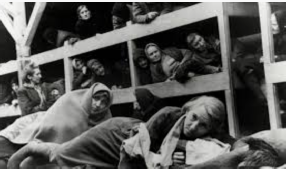
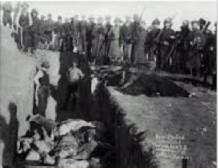
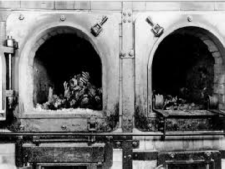
THE
INCREDIBLE
STORY OF THE JEWISH PEOPLE
